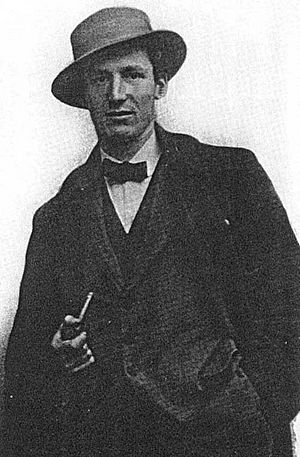Antonio Sant'Elia facts for kids
Quick facts for kids
Antonio Sant'Elia
|
|
|---|---|

Antonio Sant'Elia in his twenties in Milan, c. 1908-16
|
|
| Born | 30 April 1888 |
| Died | 10 October 1916 (aged 28) Gorizia, Friuli Venezia Giulia
|
| Nationality | Italian |
| Occupation | architect |
Antonio Sant'Elia (born April 30, 1888 – died October 10, 1916) was an Italian architect. He was a very important member of the Futurist movement in architecture. Even though he didn't build many buildings, he is famous for his amazing drawings and how he influenced modern architecture.
Contents
Early Life and Studies
Antonio Sant'Elia was born in Como, a city in Lombardy, Italy. He first trained as a builder. Later, he studied at the Brera Academy in Milan and then at the University of Bologna. He finished his architecture studies in 1912.
In the same year, he opened his own design office in Milan. He soon joined the Futurist movement after meeting Filippo Tommaso Marinetti. Futurists were artists who loved speed, technology, and the excitement of modern life.
His Ideas and Writings
Sant'Elia is known for a very important paper called the Manifesto of Futurist Architecture. It was published in 1914. In this paper, he shared his big ideas about how buildings should look in the future.
He believed that buildings should be made from new materials and have bright colors. Sant'Elia imagined a future city that was very modern and used lots of machines. He saw this city not as separate buildings, but as one huge, connected place with many levels. It would be designed to fit the busy "life" of the city.
Designing the "New City"
Between 1912 and 1914, Sant'Elia started drawing many sketches for his futuristic "Città Nuova" (which means "New City"). He was inspired by big cities in the United States and by other architects like Otto Wagner.
Many of his drawings were shown in an art show in Milan in 1914. Today, about 170 of his original drawings are kept at the Pinacoteca Civica di Palazzo Volpi, Como.
Sant'Elia's drawings showed huge, tall skyscraper buildings. They had terraces, bridges, and walkways high in the air. His designs showed the excitement of modern architecture and new technology.
Sant'Elia was very proud of his country. When World War I started in 1915, he joined the Italian army with other Futurists. Sadly, he was killed during the war in 1916, near Gorizia.
His Lasting Influence
Antonio Sant'Elia didn't get to build many of his designs. Some of his few completed works include Villa Elisi in San Maurizio and a War Memorial in Como. The War Memorial was finished by another architect, Giuseppe Terragni, in 1933.
Even though most of his designs were never built, his amazing ideas about the future city have influenced many architects. People like John Portman and Helmut Jahn were inspired by him. His vision also influenced the look of future cities in movies. For example, the famous films Metropolis (from 1927) and Blade Runner (from 1982) show cities that look a lot like Sant'Elia's drawings.
Works
- La Città Nuova, 1914
Image gallery
See also
 In Spanish: Antonio Sant'Elia para niños
In Spanish: Antonio Sant'Elia para niños
- Futurist architecture






